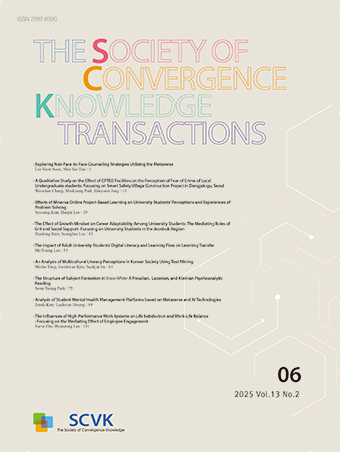Research Article
Abstract
References
Information
이 프로젝트는 전자공학과관련 학과의 필수 교과목인 ‘전자회로’에서 PBL을 수행한 결과이며, 제품을 설계하고 제작하는데 주안점을 두었다. 제품을 만들어 보는 경험은 많은 공학교육관련 프로그램에서는 중요한 주제이며, 실제로 경험이 있는 엔지니어를 요구하는 취업시장에서도 큰 경쟁력을 가지고 있다. 본 연구에서는 아날로그 전자회로는 물론 디지털이론, 마이크로프로세서와 C 언어 등 다양한 교과목의 내용을 통합하고, 공학적인 설계능력을 배양하도록 문제를 구성하였다. 팀활동을 강조하였으며 브레인스토밍을 통하여 다양한 아이디어를 제안하고, 개발하고자 하는 장치의 타당성을 검토하였다. 적외선 방출기 및 검출기, 그리고 마이크로프로세서를 이용하여 모터와 디스플레이를 제어하는 하드웨어를 최종적으로 구현하는 것을 목표로 하였다. 강의중심 수업과 비교하여 강의평가의 결과는 매우 우수한 편이었으며, 특히 PBL 만족도의 경우 학생들은 협업(Collaboration)의 항목에 가장 긍정적으로 답변하였다.
This project is the result of performing PBL in ‘Electronic Circuit’, a compulsory subject of the Department of Electronic Engineering, and focused on designing and manufacturing products. The experience of making a product is an important topic in many engineering education-related programs, and it has great competitiveness in the job market that requires engineers with practical experience. In this study, the contents of various subjects such as digital theory, microprocessor and C language as well as analog electronic circuits were integrated. The problem was structured to cultivate engineering design ability. Team activity was emphasized, various ideas were proposed through brainstorming, and the feasibility of the device to be developed was reviewed. The ultimate goal was to implement a hardware including an infrared emitter and detector, and a microprocessor to control the motor and LCD display. Compared to lecture-oriented classes, the results of class assessment were very good. In particular, in the case of PBL satisfaction survey, students answered the keyword of Collaboration most positively.
- 최정원, 장경원, "PBL로 수업하기(Problem-Based Learning)", 2판, 학지사, 2017.
- 강인애, 정준환, 정득년, "PBL의 실천적 이해 - PBL 수업을 위한 길라잡이", 제1장. PBL의 이론적 배경: 구성주의, pp.15-47, 문음사, 2016.
- O. Ortiz, and P. Leiffer, "Project-based Service Oriented Projects as a Way to Learn and Apply Analog Electronics", American Society for Engineering Education, AC 2012-4009, 2012.
- H. R. Underwood, "Improving Experience with a Metal Detector Project for Electromagnetics", American Society for Engineering Education, 2019 ASEE Annual Conference & Exposition, Paper ID #25686, 2019.
- J. Kim, "An Ill-Structured PBL-Based Microprocessor Course Without Formal Laboratory", IEEE Transactions on Education, Vol. 55, No. 1, pp. 145-153, Feb. 2012.https://doi.org/10.1109/TE.2011.2156797
- T. L. Floyd, "Electronic Devices", Chap.3 Special-Purpose Diodes, pp. 163-169, 4th Ed., Prentice-Hall Inc., 1996.
- A. Luna, and M. Chong, "A PBL Approach for Teaching Electronics Fundamentals by Developing Robotics Projects", 2020 XIV Technologies Applied to Electronics Teaching Conference (TAEE), pp. 1-7, 2020, doi: 10.1109/TAEE46915.2020.9163791.https://doi.org/10.1109/TAEE46915.2020.9163791
- A. Mantri, S. Dutt, J. P. Gupta, and M. Chitkara, "Using PBL to Deliver Course in Digital Electronics", Advanced in Engineering Education, Vol. 1, No. 1, pp. 1-17, Spring, 2009.
- E. S. Zancul, T. T. Sousa-Zomer, and P. A. Cauchick-Miguel, "Project-based Learning Approach: Improvements of an Undergraduate Course in New Product Development", Production [online]. 2017, v. 27, n. spe [Accessed 19 September 2021], e20162252.https://doi.org/10.1590/0103-6513.225216
- Publisher :The Society of Convergence Knowledge
- Publisher(Ko) :융복합지식학회
- Journal Title :The Society of Convergence Knowledge Transactions
- Journal Title(Ko) :융복합지식학회논문지
- Volume : 9
- No :3
- Pages :127-136
- DOI :https://doi.org/10.22716/sckt.2021.9.3.035




 The Society of Convergence Knowledge Transactions
The Society of Convergence Knowledge Transactions







